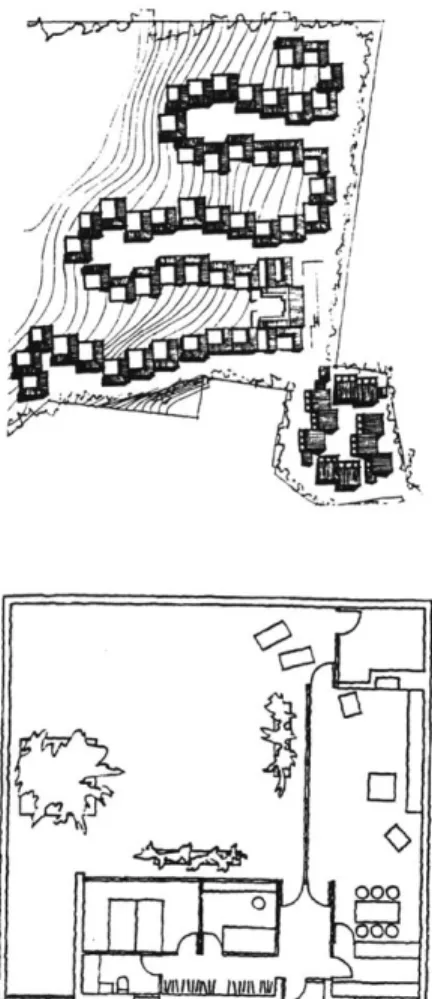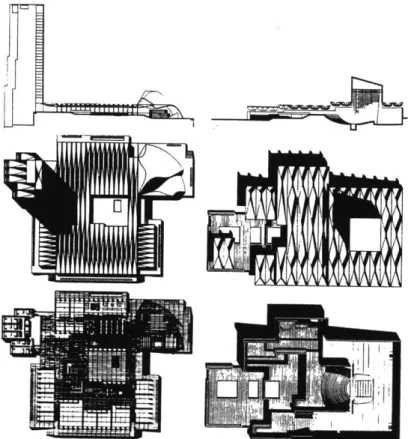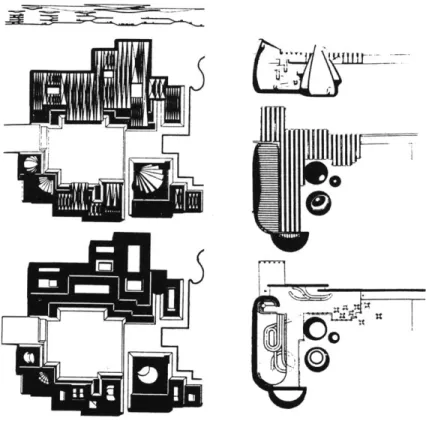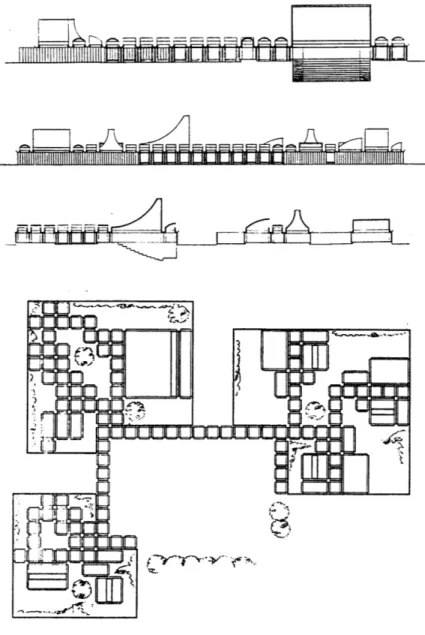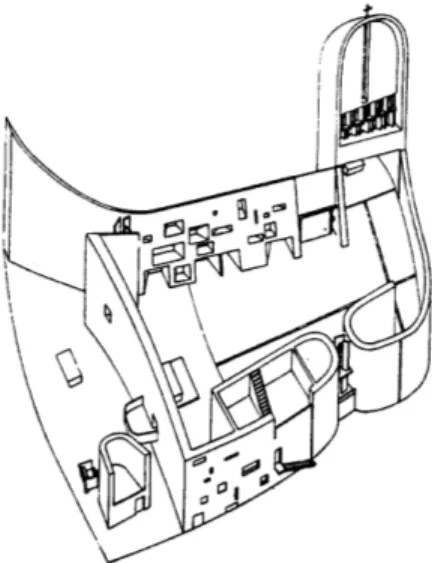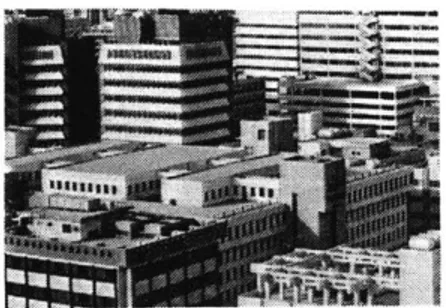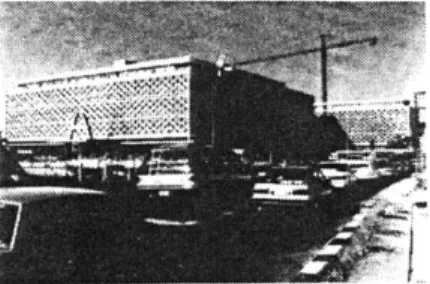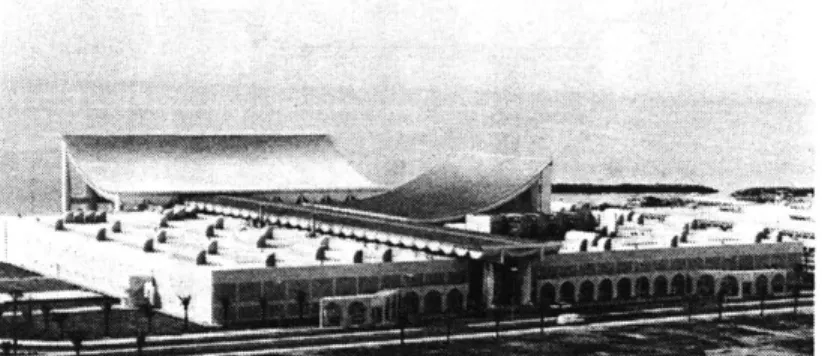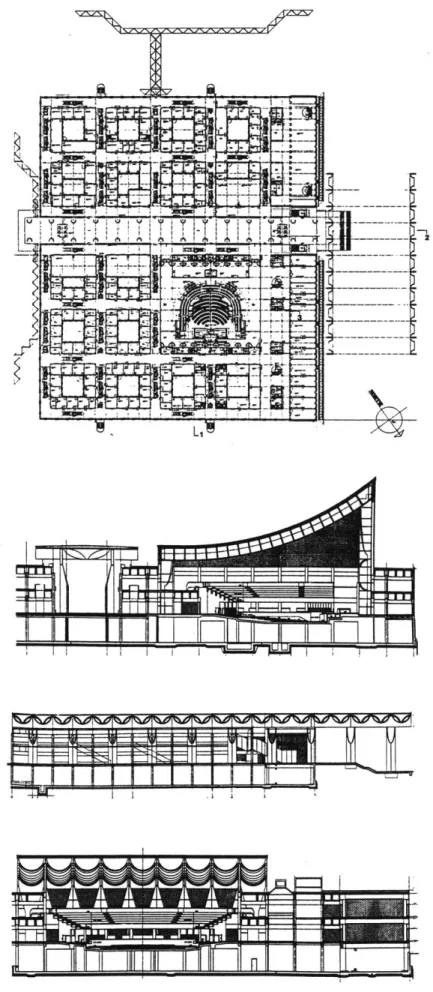Architecture Beyond Cultural Politics:
Western Practice in the Arabian Peninsulaby Tarek Beshir Bachelor of Architecture Cairo University Cairo, Egypt June 1981
Submitted to the Department of Architecture in partial fulfillment of the requirements for the degree Master of Science in Architecture Studies at the
Massachusetts Institute of Technology June, 1993
@ Tarek Beshir 1993. All rights reserved.
The author hereby grants to M.I.T. permission to repro-duce and to distribute publicly copies of this thesis docu-ment in whole or in part.
Signature of Author: Certified by: Accepted by: Tarek Beshir Department of Architecture May 7, 1993 Sibel Bozdogan Assistant Professor of Architecture Thesis Supervisor
Julian Beinart
Chairman
Departmental Committee for Graduate Students
Rofch,
MASSACHUSETTS INSTITUTE OF TFCI4inI nrv
Architecture Beyond Cultural Politics:
Western Practice in the Arabian Peninsula.by
Tarek Beshir
Submitted to the Department of Architecture on May 7, 1993 in partial fulfillment of the requirements for the Degree of Master of Science in Architecture Studies
ABSTRACT
Much of the recent architectural discourse in the Gulf States is permeated by a passionate preoccupation with narratives of identity and self-definition. During the last two decades, these states invited an overwhelming num-ber of western architects to participate in development projects. The work of these architects appears to involve a multitude of interpretations. At one end is the architect's own theoretical position and autonomous architectural discourse, while at the other end is the cultural and ideological circumstances by which the architect's work and ideas are received and understood.
This study is focused on two institutional buildings de-signed by two western architects: the Ministry of Foreign Affairs in Riyadh by Henning Larsen, and the National Assembly in Kuwait by Jorn Utzon. A critical reading of texts and representations of these buildings provides a vehicle to expose the explicit and implicit theoretical positions of the two architects and to offer a critique of the cultural politics of identity by which the architect's work and ideas are received.
This study argues that the "discursive practice" and the cultural politics underlying the work of architecture serve to place identity as the centerpiece of discussion which in turn reduces architecture to a set of prevalent character-izations and obscures any meaningful analysis of work and ideas.
Thesis Supervisor: Sibel Bozdogan. Title: Assistant Professor of Architecture.
Acknowledgments
First and foremost, I wish to thank the Aga Khan Program for making this endeavor possible and providing me with this invaluable opportunity to study at M.I.T. I would like to acknowledge my indebtedness to my thesis advisor, Sibel Bozdogan for her invaluable guid-ance and constructive criticism which helped a great deal in focusing and clarifying the structure of my arguments. Her courses and intellectual rigor has been the source of inspiration.
Iam grateful to Ronald Lewcock for his sustained encour-agement and insightful comments. I also wish to thank Masood Khan for his continuous support and for sharing his insights and time with me. To Akos Moravinski, I am also indebted for his helpful criticism and guidance. My special thanks and great debt to Khaled Asfour for his continuous concern, invaluable help and encouragement over long distance calls. I would like to extend my appreciation to the staff of MIT libraries specially to Omar Khalidi for his assistance in obtaining the neccessary material.
To May and Yasser who made my stay at MIT and Boston, rather pleasant and to whom I owe much more than I can express. My two years would never have been the same without Wael Al-Masri.
Last but not least, no words can express my gratitude towards my wife and companion Nadia, for her unflag-ging support in all my endeavors and who has bared my continuous inconveniences without complain. To her continuous sacrifices along with her refreshing optimism, I am indebted. To my daughter Yasmeen who brought happiness, liveliness and blessings with her coming to our lives.
Table of Contents
Abstract 3
Acknowledgements 5
Table of Contents 7
I. Introduction 9
II. The National Assembly Building in Kuwait
by Jorn Utzon 23
Utzon's work in the context of Western theory The Political and Cultural Context of the Kuwait National Assembly building
Building program
The monumental canopy
Folded roofs versus 'billowing tents' The traditional bazaar
III. The Ministry of Foreign Affairs in Riyadh
by Henning Larsen 49
Larsen's work in the context of Western theory The Political and Cultural Context of the Minis-try building
Competition statements and building program 'Lessons from the Orient'
Anonymous facades
A bureucratic corridor versus a merchant's bazaar
Courtyards and the 'Islamic dream of paradise' The urban complex
The modem mushrabiyya Discursive interpretations
The building and the text: a world apart
IV- Reflections 79
Appendix 89
Sources of Illustrations 93
I
Introduction
Introduction:
During the last two decades, particularly after the oil boom, the Kingdom of Saudi Arabia and the State of Kuwait invited a sizable number of western architects to design many of their major institutional buildings. This study attempts to understand the complexities involved in the work and practice of western architects in the Gulf region. Two major institutional buildings are selected as case studies. Both buildings were designed by two prominent western architects: the Kuwait National As-sembly in Kuwait by Jorn Utzon and the Ministry of
Foreign Affairs in Riyadh by Henning Larsen.
Institutional buildings in the Gulf region are usually a form of cultural representation reflecting the client's projected identity or some version of the architect's own judgements. These buildings, designed by western archi-tects, often provoke a set of questions that impinge on the architectural production itself: what are the implicit and explicit theoretical positions of the architect and is there a discrepancy between them? What is the architect's understanding and knowledge of the other culture? How far does the architect respond to the client's expectations? What are the cultural and ideological circumstances in which his work and ideas are received?
The thesis attempts to investigate these questions from within the epistemological framework that the architec-tural artifact possibly involves the simultaneous under-standing of two levels of thinking. First, the architect's private level of thinking, that is, his theoretical positions and relative program of action which are consistently present in his body of work and frequently assert his axioms. Second, the public level of thinking that
encom-passes the culture at large with which the architect inter-acts. The artifact produced by the architect, in the first case, is based on an autonomous body of architectural knowledge which avoids its cultural situatedness. In the second case, however, the artifact is the product of cul-tural predicaments based on ideological, political and socio-economic factors.1 Between the two levels of think-ing there is an interaction that can be described as recip-rocal and can influence the relation between architecture and culture in general.
This epistemological framework acquires a special posi-tion in the practice of western architects in the Gulf region. The relation between the two levels of thinking, although initially reciprocal and intertwined in nature, eventually becomes convoluted where the second level of thinking dominates. A reciprocal relationship takes place when the architect shapes his building according to his own sphere of architectural knowledge and theoreti-cal positions taking into consideration the cultural mi-lieu, the environment and the client's interests and expec-tations. A convoluted relationship then comes into play when the architect's work and ideas are introduced to his client's culture to acquire a new body of meanings, a new set of rational arguments that might be independent from his initial sphere of knowledge.
In this vein, the architect may begin to respond by hold-ing two different positions at the same time: one implicit and the other explicit. His espoused theory of action (his explicit position) which he adopts as the basis of his communication with others, may or may not be compat-ible with the theory-in-use which actually governs his actions (implicit position).2
In their theoretical statements and architectural posi-tions, architects, as well as critics, may then come to stress
or rather inflate the second level of thinking at the ex-pense of the first, especially if their text and theoretical arguments is read by the audience of the client's culture. Michel Foucault dismisses the credibility of such type of text which frequently results in a "reductionist" approach. He stresses the importance of recognizing the discontinuities, inconsistencies or contradictions that run throughout cultural history. Foucault calls for building up a new approach to which he gives the name Archaeol-ogy.3 He describes 'Archeology' as an anti-reductionist approach which rejects flattening out or suppressing evidence in order to create a story which may be simpler or more cogent. Archaeology, according to Foucault, is the activity of putting together fragments which appear to be disconnected and disparate, while knowing that it will never be possible to assemble all the parts or create a whole picture.
The act of re-introducing the artifact through a new set of rationales different from the initial set which were estab-lished to satisfy a particular agenda, that is specifying 'a legitimate perspective for the agent of knowledge' and 'fixing the norm for the elaboration of concepts and theories,' is coined by Foucault as "discursive practice." According to him, "discursive practice" is the interaction between theories and production. He argues that pre-scriptive theories, which come out of a "discourse" do not necessarily coincide with all individual works, even if these theories are manifested through individual works or announce their presence for the first time through one of them.4
Foucault's ideas of 'discourse' and 'discursive practice,' are inspirational for this study and offer insights the implications of which are relevant to a critical evaluation of the work of western architects in the Arabian Penin-sula.
To be able to pursue "discursive practice," there must be a discourse that is initiated by certain actors. One set of actors are renowned architects, journalists, critics, histo-rians, theoreticians and other intellectuals; all in great capacity, contribute to making and shaping the discourse of architecture that acts within a particular culture. Hence these actors play a crucial cultural role in influencing the way buildings are interpreted and evaluated.
In the Gulf region, there is another influential set of actors, namely, government agencies and cultural intel-lectuals. They tend to shape the official taste for architec-ture in accordance with changing political agendas and even regroup periodically the public opinion around this particular taste. These two set of actors meet each other through various discursive fields, one of which is compe-titions. The second set of actors invites the first to partici-pate in design competitions either as evaluators or pro-ducers of ideas. Maximum agreement between the two parties evolves when "discursive practice" is brought into forceful play between them.
Design competitions sponsored by government agencies in the Gulf become a major architectural event when the subject of the competition is a prestigious enterprise. Competitions, in this case, bring several issues to discus-sion. First and foremost, the selection of internationally renowned architects for the competition by the promise of a sizable financial reward, ensures, to a great extent, a higher quality of return for investment on the sponsor's part. Second, the client's choice of jury members (pre-dominantly a team of foreign consultants) and the an-nounced design criteria express certain architectural pre-occupations of the culture. Third, announcing the com-petition internationally brings prestige and publicity to the sponsors and promotes national pride through world recognition.
"Discursive practice" enters the process of design compe-titions the moment thestatements of objectives arespelled out. Usually these statements are loaded with phrases that emphasize polarities and oppositions such as mo-dernity and tradition, past and future, vernacular and monumental; to name but few of the most popular terms. Many of the self-conscious historical references taken by western architects from the so-called generic tradition of "Islamic Architecture" are implied in the competition brief. For example, the brief written for the competition of the Ministry of Foreign Affairs in Riyadh states that the main criterion is "to create a contemporary symbol of Islamic ideals which acknowledges the architectural tra-ditions of Riyadh." In the case of Baghdad State Mosque competition, the brief stressed that "the monument should synthesize the history and heritage of Islam with the contemporary quality of life," and that "the design should follow Arab-Islamic style."
With these kinds of briefs, architects should then try to mediate between those binary opposites such as "history and heritage of Islam" versus "contemporary quality of life." They should resolve the riddle of "contemporary symbol of Islamic Ideals." Perry Neubauer, the chief architect of The Architects Collaborative (TAC) who was responsible for the design of several projects in the Gulf States, once reflected on this ambiguous situation by stating that, "None of our Arab clients have been able to explain in words how to express the Islamic style - or even what it is, for that matter. Rather they suggest that we visit important buildings and open spaces to interpret what we see in a modern concept."s Perhaps Neubauer's statement is harsh on the client, yet apparently it helps to divert the blame away from western architects who pur-sue "discursive practice." For if they cannot meet the vague expectations of the brief through their design
solution, then at least through textual description of their projects. The thesis focuses on the discrepancy between the two.
Vagueness in competition descriptions may not be pro-moted by the inability of the client to explain precisely his objectives, as Neubauer suggested, but perhaps by the desire to demonstrate the ability of the developing coun-tries to equate with the West on its own terms. Clifford Geertz depicts this situation:
The peoples of the new states are simultaneously animated by two independent, yet distinct and often opposed aspirations -the desire to be recognized, the assertion of the self and a demand that their identity is publicly acknowledged 'as being some-body in the world'; and the desire for progress and for 'playing a part in the larger arena of world poli-tics,' and exercising influence among nations.6
The situation of Arab cultures caught between "opposed aspirations" started in the 50s and 60s when many of the old cities witnessed wholesale demolition of the tradi-tional fabric to make way for wide streets and modern building blocks. Large avenues and roundabouts repre-sented the triumph of the automobile in the metropolis. Many of the traditional buildings were perceived by city planners and government officials as obstructions to the modern interventions. The move towards 'modernism' in architecture was quite radical. It was espoused on the highest levels of the administration with unanimity and was implemented at all governmental levels with persis-tence. The tacit agenda of most of the governments in the Gulf region was to catch up with the material culture and technological advancement of the West. A direct appro-priation of the "International Style" in the form of corpo-rate towers and mass building blocks was adopted in the
region similar to that developed in the Western world during the 50's.
The decades of the 70's and 80's, however, witnessed a conspicuous shift on the architectural scene in many of the Gulf cities. The period was marked by a renewed interest in issues of cultural identity and Islamic tradi-tion. Notion of 'Islamic architecture' came to the fore. With a new found respect for the great achievements of the past, the architectural culture in many of the Gulf states were searching for ways to reproduce in their contemporary architecture some of the vocabularies and forms of the traditional architecture particularly those which were identified as 'Islamic.' Alarmed by the disas-sociation of their cultural roots and the eradication of their traditional fabric, the architectural society in many of the Gulf countries became increasingly interested in issues of identity and self-definition. Consequently, terms such as authenticity, cultural continuity and local heri-tage came into vogue and progressively gained adher-ence.
This shift in attitudes towards history and traditional architecture in the 70's and 80's was coupled by an attack on modem architecture. The complexities of the'Modern Movement' had no place in the minds of many Arab architects and architectural intellectuals. Terms like'Mod-ern,''Modernism,' and 'International Style' were lumped together and referred to as the source of the plight and facelessness of contemporary architecture in the Arab world. Return to the past was proposed as a solution to rectify the evils of 'Modern' architecture.
Sayyed Hussien Nasr, for example, advocates an anti-modernist stance and stresses the essentiality of tradition in increasing the authentic environment. He argues that modernity and modernization caused contemporary
designers to lose their inner sense of beauty, dignity, harmony and nobility which characterized the authentic manifestation of the Islamic spirit.7 Secularization that spread in cities killed the imagination of the traditional Muslim artist who was nourished by symbols drawn from the Quran.8
According to Nasr, the solution to the crises within the Islamic architecture and the modem cities lies in a return to, what he calls, "traditional Islamic architecture" which he believes to be still alive in villages and small towns. Similar authors proposed architecture of resistance (syn-onymous for traditionalism and revivalism) as an alter-native to re-establish continuity with the past and eradi-cate the impact of modernism.9
The preoccupation with issues of 'tradition' and 'moder-nity' in the Arab world, had its roots in the Western architectural discourse. The unified'Modern Movement' of the 30's, depicted in the writing of influential historians such as Giedion, Pevsner and Hitchcock, was heavily scrutinized as the concern for historicism gathered mo-mentum by the 70's. Since then, western architects, critics and historians advocated the coexistence of tradition and modernity. For example, Colin Rowe and Fred Koetter invented the term "collage" and "bricolage" as devices of assembling elements and forms together from modern and traditional histories.10
This new approach, among others, called for "pluralistic" and "inclusive" attitudes to architecture rather than "ex-clusionist" and "reductionist" approaches that had come to dominate the architecture scene in the mid-twentieth century. There was the emphasis on establishing visual links with the past through the use of both historical forms and applied decoration. Robert Venturi, for ex-ample, argued for establishing the symbolic and
sceno-graphic dimensions of architecture as opposed to ab-stract, compositional concerns. "As an architect," he says, "I try to be guided not by habit but by a conscious sense of the past, by precedent, thoughtfully considered...I am for richness of meaning rather than clarity in mean-ing, for the implicit function as well as the explicit func-tion."11
This pluralistic approach took many directions, however, some of which espoused polemical attacks on 'Modern-ism' such as that of Charles Jencks, who introduced the term "post-modernism" as a reaction against all forms of modernist expression in architecture. These polemical attacks and theoretical statements moved to the Arab world to become the dominant discourse on the architec-tural scene. The irony is that although recent critical theory in the West has already rectified the distorted image of the modem movement12 and showed how it
was invented as a unified doctrine,13 there is still too much anti-modern rhetoric - comparable to that in the West - taken on board by many local architects and critics in the Arab world.
More relevant to my thesis, the attack on modernism forces many of the foreign architects involved in projects in the Gulf region, to pursue a "discursive practice" and become totally determined in their explicit positions to have their work accepted by their Gulf client. Pleasing the Gulf client is not the only incentive to pursue a "discursive practice" by Western architects. They are also motivated by the possible gain of an Aga Khan Award for
Excellence in Architecture which was established in the late
70's. Not only is the Award one of the best paying cash prizes in the architecture field, but is always surrounded by sizable media coverage. To win the award means instant fame and more commissions in the Muslim world. For architects to win the Award, they should work hard
to localize their designs, even if this means starting with some "remote" theoretical premise and wrapping the architectural product with terms that are "close" to the local context.
It is in this kind of environment that the two western architects, Henning Larsen and Jorn Utzon, worked out their buildings: the Ministry of Foreign Affairs and the Kuwait National Assembly. Famous as they are, for producing quality design backed by theoretical positions in their own cultures, these architects come to produce buildings in the Gulf where they engage themselves in cultural rhetoric. Vague descriptions of briefs may not be the only reason. Edward Said may tell us about another. It is the discourse of Orientalism in which the architects may engage themselves. Said writes:
Orientalism can be discussed and analyzed as the corporate institution for dealing with the Orient
-dealing with it by making statements about it, autho-rizing views of it, describing it, by teaching it, settling it, ruling over it: in short, Orientalism is a Western style dominating, restructuring, and having author-ity over the Orient.14
There are two branches of the Orientalist discourse. The first pertains to a group of artists and scholars, mainly from Western Europe, who travelled to the Orient from the seventeenth century onwards and gradually estab-lished the latter as the subject matter of representation through illustrated travel accounts, paintings and sketches. The Orient, as Said has shown us, was system-atically objectified by these travelers into a form of dis-course as well as into a stereotypical image for consump-tion and a stylistic category in architecture. More rel-evant to the thesis is the second branch of Orientalists which is linked with the contemporary scholars who are
still hitherto, interested in the study and interpretations of the Orient, particularly Islamic cultures.
Contemporary scholars specialized in the art and archi-tecture of the Muslim world produce texts that constitute a primary source for western architects. Some of these texts are fraught with distortions that range from sweep-ing generalizations and unification of periods and styles to assumptions based on the negation of the West. Ernst Grube, for example, characterizes the architecture of the Islamic world as 'hidden architecture.' 5 He emphasizes the 'interiority' of all Islamic architecture and argues that it is rare that an 'Islamic building' can be understood, or even its principle feature identified, by its exterior. Moreover, he perceives Islamic architecture as antitheti-cal to that of the West. He writes," Islamic architecture at its best, and at its most 'Islamic,' is truley a negation of architecture as conceived in Europe."'6 In this respect, Grube authoritative remarks on the architecture of the Islamic world reflects an Orientalist discourse which is determined to prove the authority of the West over the East through a "reductivist" scholarship.
The problem lies in the fact that many western architects working in the Gulf, rely on such texts that had already undergone a "discursive practice." How then can they escape the same practice? The thesis focuses on this line of thinking since the work of Utzon and Larsen in the Arabian Peninsula is no exception.
In the light of this, the work of both architects in the Gulf region will be critically examined in the context of two settings: the first is the architect's own theoretical posi-tion in relaposi-tion to the major preoccupaposi-tion of the architec-tural culture at large. The second setting is the ways in which his work and ideas were received and presented in the Arabian Peninsula.
Notes:
1 Michael Hays, "Critical Architecture: Between Cul-ture and Form,"Percpecta 21, (1984), pp. 15-29.
2 Royston Landau, "Notes on the concept of an archi-tectural position," AA Filess 1, (81-82), pp. 111-114. See also, Argyris, Chris and Schon, Donald, Theory in
Practice: Increasing Professional Effectiveness,,
Jossey-Bass, 1974.
3 Michel Foucault, The Archaeology of Knowledge, New York: Pantheon Books, 1972.
4 Michel Foucault, "History of Systems of Thought,"
Language, Counter-memory, Practice, Cornell, 1977, p.
199.
5 Glenn Lawry, American Architects in the Arab World, American Arab Affairs Council, 1983, p. 3.
6 Clifford Geertz, The Interpretation of Cultures, New York: Basic Books, 1973, p. 258.
7 Sayyed Hussein Nasr, "The Contemporary Muslim and Architectural Transformation of the Islamic Ur-ban Environment," Towards an Architecture in the Spirit
of Islam, (The Aga Khan Awards for Architecture)
Philadelphia, (1980), p.2 8 Ibid.
9 Examples of other writers that advocate a similar approach, but less philosophical, are Tareq Abdel Fattah "Modem Architecture in Kuwait" in Al-Benaa (April/May 1989); pp. 38-42; and Udo Kultuman in
Mimar who maintained this line of thought
through-out all his articles, see "Contemporary Arab Architec-ture: The Architecture of the Gulf States" in Mimar, (Dec. 1984), pp. 50-57.
10 Colin Rowe and Fred Koetter, Collage City, Cam-bridge: MIT Press, 1978.
11 Robert Venturi, Complexityand Contradiction in
Archi-tecture, New York: Museum of Modem Art, 1977, p.
16.
12 See Stanford Anderson, "The Fiction of Function,"
Assemblage 2 (February 1987), pp. 19-32.
13 See Georgio Cuicci, "The Invention of the Modern Movement," Oppositions 24 (Spring1981), pp. 69-91. 14 Edward Said, Orientalism, New York: Vintage Books,
1987, p.3.
15 Ernst Grube, "What is Islamic Architecture,"
Architec-ture of the Islamic World: It History and Social Meaning
(George Michell ed.), London: Thames and Hudson, 1978, pp. 10,11.
II
The Kuwait National Assembly
Kuwait by Jorn Utzon
Utzon's work in the context of Western theory:
Utzon's early academic experience at the Royal Academy of Art in Copenhagen was under the direction of the historian and town planner Steen Eiler Rasmussen. His first key inspiration was Alvar Aalto and GunnerAsplund whom he worked with in 1945. The brief apprenticeship with Aalto left a strong influence on him and nourished his sense for the physical and natural context. Working with the French sculptor Henri Laurens, Utzon was pro-foundly influenced by the former's perception of sus-pended sculptural forms.1
In 1947, Utzon set up his first partnership with the archi-tecture historian, Tobias Faber. Following the theories advanced by D'Arcy Thompson in his book 'On Growth and Form,' Utzon and Faber issued a joint manifesto, entitled, 'Trends in Contemporary Architecture' wherein they attempted to derive their architecture from natural forms of accretion and growth.
Utzon's affinity with landscape shaped by topography, material, craft and architecture engendered by natural forces is a fundamental tenet in his architecture. The architectural critic Peterson testifies to Utzon's affinity withnature. He writes, "To this artist, there is no essential difference between a city organism and a plant organism. He deducts living truths from the construction of nature and reshapes them quickly into rough drafts of houses for human beings... His houses grow, like organisms, they reflect the form of nature's growth, they are not theoreti-cal frameworks for human life but live their own life because they are structured according to the same physi-cal laws that govern their inhabitants."2
The period between 1945 and 1957 of Utzon's life was one of assimilating a great variety of places and cultures and
integrating his experiences into a comprehensive and coherent design philosophy. His extensive travels to the Far East were already a manifestation of his tendency to seek inspiration outside the Scandinavian tradition. A visit to Morocco in 1948 supplied Utzon with a model for his notion of 'additive architecture' which he adopted in several of his housing schemes. In 1949, a scholarship took him to Taliesen West and Taliesen East where he spent a short time with Frank Lloyd Wright by whom he was profoundly influenced. The first example of this influence was Utzon's own house in Hellebaek built in 1952 which was an independent interpretation of Wright's Usonian houses.
Utzon's encounter with different cultures and places led remote themes to converge into ideas dormant in his own creativity. In many cultures which he visited including that of Mexico, China, Nepal, India and Japan; he noticed an almost generic opposition between a heavy-weight podium and a light-weight roof that floats above it.3 In his seminal article "Platforms and Plateaus: The Ideas of a Danish Architect," published in 1963, Utzon posits the roof/platform paradigm as a mean of architectonic ex-pression and structural composition. The physical ten-sion induced by the opposition of hovering roofs and strong earth hugging platforms defines his architectural space and unfolds in his work one after the other, where it is invariably rendered as a shell roof or a folded slab structure suspended over a terraced earthwork. Accord-ing to Utzon, "(T)here is a magic in the play between roof and platform."4 The origin of the roof/platform is clearly manifested in his early generic sketches.
When he wishes to show the nature of the Japanese house, Utzon sketches the roof hovering above the floor, without including the transparent walls (Fig. 1). He
7
71
7h-Fig. 1
sketch.
Japanese house, conceptual
Fig. 2 Clouds over the sea, concep-tual sketch.
Fig.3 Sydney OperaHouse,prelimi-nary sketch.
Fig. 4 Sydney OperaHouse, concep-tual sketch.
Fig. 5 Sydney Opera House, final sketch.
Fig. 6 Bagsvaerd Church, prelimi-nary sketch.
Fig. 7 Bagsvaerd Church, final sketch.
describes the floor in a traditional Japanese house as "a delicate, bridge-like platform. This Japanese platform is like a table, and you do not walk on a table top. It is a piece of furniture."5
The'clouds over sea'sketch depicts the sea as a horizontal line with mounting clouds above it (Fig. 2). This sketch is a prefiguration of the shell roof of the Sydney Opera House where Utzon perceives the roof as hovering over the horizontal podium and touching it at certain points (Fig. 3, 4, 5). Utzon's ideas and intentions behind this project are clearly stated in his own words:
The Sydney Opera House is one of those buildings where the roof is of major importance. It a house which one will see from above, will sail around, because it sits on a point sticking out into a harbor... This means that one could not design a building for such an exposed position without paying attention to the roof. One could not have a flat roof filled with ventilation pipes, in fact, one must have a fifth facade which is just as important as the other facades.6 Utzon's preliminary sketches for the Bagsvaerd Church confirm his penchant for the roof/platform idea. First, he sketches a group of people standing on a ground which extends towards a distant horizon with clouds offering spatial definition to the scene (Fig. 6). In his second sketch, however, the same elements are present, but the ground is treated as a built floor and the clouds are depicted as a series of hovering vaults. Between floor and
10
ceiling, the group of human beings are directed towards a large cross (Fig. 7).
Although Utzon's preoccupation with the notion of 'roof and platform' is not articulated as an explicit theoretical statement, yet it may be read as a departure from a search for initial principles and primary axioms in architecture, comparable to the 'primitive hut' posited by Laugier in
his Essai sur L'architecture of 1753 and Semper's formula
of the opposition between the tectonics of the roofwork and the stereotomics of the earthwork.7
Utzon's countervailing but complementary opposition of roofs and platforms generally appears in three type-forms, each being largely determined by a variation in the roof. The first of these types, the courtyard and the mono-pitched roof, appears in two related housing schemes
realized in the early sixties: the Kingo and Fredensborg
residential settlements. The houses are composed of
L-shaped courtyard units covered by light-weight Fig.8 TerraceHousesatFredensborg,
monopitched roofs and arranged in contiguous clusters North Zealand, 1962-63,general site
plan and ground floor plan of a
typi-with the potential to accommodate themselves to any cal unit with garden.
topography (Fig. 8, 9).
Fig. 9 Kingo Houses, near Elsinore, Zealand, 1950-60, general site plan, cross section and ground floor plan of a typical house unit with garden
Fig. 10 Competition scheme for the highschoolat Elsinore,Zealand 1958,
longitudinal section, roof plan and ground floor plan. (left)
Fig. 11 Competitionschemefor World Exibition, Copenhagen 1959, longi-tudinal section, roof plan and ground floor plan. (right)
In the second type, the roof-work consists of a folded slab suspended above a raised earthwork. The folded-roof type manifests itself in Utzon's proposals in the late fifties for the High School at Elsinore in Denmark (Fig. 10). Also, this type appears in Utzon's competition schemes for the Zurich Opera house, the World Exhibition in Copenhagen and the Art Gallery project inSilkeborg (Fig. 11, 12, 13). The third type, the shell-roof usually sur-mounts assembly halls and appears repeatedly in the above mentioned projects attaining its fullest expression in the Sydney Opera House (Fig. 14).
Utzon's penchant for shell-forms and folded roofs plays an important role in his architecture. Concrete shells cover the public assembly halls, while the folded roofs cover the podium which accommodates generic institu-tional spaces. In most of his projects, shell roofs appear as public, symbolic elements that are readily
distinguish-Fig. 14 Sydney Opera House, gen- able from the surrounding folded-plate roof. Thus, the
Fig. 12 Competition scheme for the Zurich Theater 1964, longitudinal section, roof plan and ground floor plan. (left)
Fig. 13 Art Gallery and Museum in Silkeborg 1963,section, roof planand ground floor plan. (right)
visibility of Utzon's assembly halls, acts as 'spaces of public appearance' equivalent to Alvar Aalto's notion of 'city crown.'
Of equal importance, is Utzon's preoccupation with the idea of 'additive architecture' where the repetition of a single spatial unit responds to the requirements for ex-tensions and modifications. The application of this addi-tive principle is evident in several projects that were designed by Utzon in the sixties particularly that of the Farum Town Centre (Fig. 15) and the Herning School (Fig. 16). These projects demonstrate the degree of flex-ibility and freedom that can be achieved by using units and components to be developed in stages or continu-ously growing organically. Also, in the Jeddah Stadium proposal of 1969 (Fig. 17), Utzon combines, in different permutations, five generic structural units, each one be-ing conceived in terms of its constitutive and connective role.8Utzon's notion of 'additive architecture' finds
par-Fig. 15 Farum Town Centergeneral layout and sections.
-44
U-Fig. 16 Herning School Center, gen-eral layout.
I, E
Fig. 17 Jeddah stadium proposal
1969, mass plan.
allel to the anthropological references underlying the work of Aldo Van Eyck and Herman Hertzberger; and Christopher Alexander's concepts
of'environmentalstruc-tures.'9
Many historians, such as Philip Drew and Sigfried Giedion, portrayed the work of Utzon's generation as antithetical to that of the early generation. Drew states that "The inapplicability of the first generation's rigid rationalistic and extrinsic formulae as templates for struc-turing the environment has forced architects among Utzon's generation to investigate relatively freer,
intrin-sic system of order. The (latter) acquired an organic outlook which involved taking instructions from the environment instead of enforcing preconceived rational-istic structures upon it."10 Thus, like Postmodernism which is typically defined as the antithesis of Modernism, the work of Utzon's generation was presented as an attempt to rectify the'rational bias'and 'explicit function-alism' of the early generation. With the work of the latter depicted as passing through a phase of 'Confusion and Boredom' during the sixties, the work of Utzon's genera-tion offered a new direcgenera-tion giving architecture a "poetic" and structural expression.11
One facet of rectifying the thought of the early generation was structural expressionism which spread in 1950s and marked the beginning of a wide range of experimentation with free roof structures. Prominent architects, such as Le Corbusier, who designed the Ronchamp Church (Fig. 18), and Eero Saarinen, who designed the TWA terminal, experimented with structural expressionism as an escape from the 'tyranny of the box.' The combination of alle-gorical forms and structural efficiency offered an oppor-tunity for reconciling "expressionism" with "rational-ism." Structural expressionism was of particular concern to Utzon where he professed in such an approach giving his buildings a rich formal language. With his Sydney Opera House (contemporary to Eero Saarinen's TWA), Utzon resolved the opposing tenets inherent in the work of the early generation: namely their claim to be scientific and rational and their tendency for an artistic and cre-ative impulse.12 This impulse and the suppressed ex-pressionistic aspects of the modern movement arguably, were traced as far back as the 1920s when Eric Mendelson built his Einstein Tower at Potsdam.13(Fig. 19)
Fig. 18 Ronchamp Church, Le Corbusier, 1952.
Fig. 19 Einstien Tower, Eric Mendelson, 1920.
The Political and Cultural Context of the Kuwait Na-tional Assembly Building:
Historically speaking, Kuwait is comprised of three main groups: the ruling family who were originally desert nomads, an oligarchy of merchants and a working class
- mostly fishermen, pearl-divers and shipbuilders. Of these groups, the second has been by far the most power-ful and dynamic social force. It was the merchants who provided the ruling family with their income in the shape of customs and duties and provided employment for the rest of the community.14
The choice of a ruler, in conformity with the tribal tradi-tion, was usually regarded as a family affair; and while clearly it was no democracy, this primitive political sys-tem allowed the Kuwaitis wide freedom of action and expression. Public opinion was an important political force, hence, it was general practice for the ruler to consult the elders of the community on matters involving serious decisions. Law and order were maintained in a simple and unpretentious way in accordance with Is-lamic law as modified by tribal usage and local custom.'5 However, this triple social structure has been altered with the recent changes in the socio-political life. Oil production which started in 1946 after the Second World War was the turning point in Kuwait's history. It transformed Kuwait from a small state into one of the wealthiest oil-producing countries. The new wealth cre-ated a demand for services to implement the ambitious programs planned by the government. Inevitably, an attractive market for labor was created and an over-whelming number of foreign expatriates flocked from other countries to Kuwait.
foreign expatriates in various development projects, it was natural that the growing size of the foreign commu-nity, not only challenged the traditional social and politi-cal structure of Kuwait, but also served to complicate the Kuwaiti sense of identity. The ethnic composition of the immigrants was heterogeneous and their social habits, cultures, creeds, and above all, political tendencies were numerous and widely divergent. So pervasive has been their influence that there is hardly an aspect of national life which does not bear their mark.
Alarmed by the potential for disruptive demographic imbalance (with the Kuwaitis numbering less than half of the total population),16 the Kuwaiti government was
prompted to take defensive measures which led to de-priving the majority of the expatriates living in Kuwait from any permanent ties with the host country. They were denied citizenship and their naturalization into the host country were extremely strict. With little or no hope of being permanently integrated into the community, foreign expatriates were left without any sense of alle-giance to Kuwait.17 As a result, a growing dissent among them increased the potential for internal problems.18 These problems were further compounded in the wake of the Iranian revolution by the religious tensions between the Kuwaiti Sunnis and the Shiite immigrants (from Iran and Iraq) who felt discriminated against by the Kuwaiti government.19 As a result, a number of terrorists attacks were directed at institutional buildings and public facili-ties in an attempt to destabilize the country's national security.
The socio-political instability coupled by the religious tensions prompted the government, as a defensive way of asserting national identity, to request that the new National Assembly building express a local character. By emphasizing this concern for local character, the building
Fig. 20 'International Style' build-ings after the oil boom.
Fig. 21 Superficial cliches.
was to be perceived by the natives as a symbol of the government's commitment to perpetuating the special privileges of Kuwaiti citizens within the heterogeneous society in which they remained a minority.
In addition, this keen interest in asserting national iden-tity -as a political expression-by dressing the building with local character was coupled by the contemporary architectural trend that called for buildings to be sympa-thetic to the architectural heritage of the society. The focus on architectural identity coincided with the wide-spread discontent with many of the 'international style' buildings constructed in the seventies (Fig. 20). As a result, the Municipality of Kuwait, supported by the Amir and the government, initiated a strong preservation campaign geared towards reviving the architectural heri-tage of the country. The diwaniyyas of the merchant families in the old city were renovated as a sign of salvaging what remained of the traditional buildings. A three-quarter scale Kuwaiti village was built in the city near the sea shore to remind the young generation of their history and architectural heritage. Old marketplaces were restored in order to "preserve the place of the souk in Kuwait's society, its connection with the country's tradition and its compatibility with modern require-ments."20 The period of the 70's marked an increasing
tendency in using superficial cliches and forms such as tents and arches and the so called 'Islamic/Arabic' style was predominant. (Fig. 21)
Building Program:
In 1973, the Kuwaiti government decided to build a new National Assembly to replace the old 'international'style Assembly Complex which was built during the 60's (Fig. 22). The decision to commission a prominent building to
house the National Assembly and the particular forms Fig. 22 Old National Assembly.
with which the building was to be carried out were manifestations of the search for identity.21
Unlike the old 1960's complex which was remote from the seat of amirial power, a far more prominent site along the Arabian Gulf was chosen to house the new National Assembly. The choice of the location was part of a larger plan intended to establish a host of prestigious buildings along the coastline. The new Assembly building was to join the Seif Palace (the administrative headquarters of the Amir), the Ministry of Foreign Affairs and the Na-tional Museum (Fig. 23). The site is a large plot of almost 120,000 sq. m. bounded by roads on three sides, one of them being the Arabian Gulf Street which runs along the sea shore (Fig. 24).
CENTER OF
KUWAIT CITY
Fig. 23 Map of Kuwait city showing the location of the old and new Na-tional Assemblybuilding.
Fig. 24 New National Assembly.
A limited design competition among six invited archi-tects, was arranged for this purpose and juried by an international team chaired by a British architect.22
Ac-cording to the program, the design was to include the National Assembly Hall; a reception hall; lounges for the Amir of Kuwait; the Prime Minister, the President of the Assembly and other officials. Also to be included in the project were individual offices for Assembly members; administration offices; a library; a restuarant and a prayer hall.
Utzon received the first prize and later he was charged with the detailed design of the complex. The plan of the entire complex is a square, based on a module of five by five meters. Departmental offices and reception halls are all organized along a main central corridor. These offices are all arranged around small courtyards, connected to the central street via side corridors (Fig. 25). The flat roof is dotted with skylights in the form of half-barrel vaults providing natural light to the corridors.
In proposing his building to Aga Khan Award, Utzon states that it stands as "an excellent synthesis of tradi-tional Arabic architectural principles and contemporary design expression.-23 Utzon's statements are clearly marked by the politics of identity and a strive to please his client by using terms of the much favored synthesis of
I~~1A I __ AI _A__
low
UM-
iii""-Fig. 25 National Assembly Build-ing, ground floor plan, longitudinal section in main corridor and cross sections in Assembly Hall.
I
LV LILJEI "im rr--L-I FT -4 rThe monumental canopy:
Fig. 26 Square canopy.
AA'
011'
z==
C! [
Ei E A,
Fig. 27 Preliminary sketches show-ing Lltzon's processional approach.
The central corridor, Utzon argues, "leads towards the ocean into a monumental canopy which gives shade to a large open space where the Kuwaiti people can meet the Amir."24 The monumental canopy (Fig. 26), according to
Utzon, functions as the old "diwaniyya"25 that houses an
Arab tradition of having a direct contact between the ruler and his people. Utzon even draws similarities between the canopy protecting the people from the se-vere sun, and the protection which the Amir extends to his subjects.
In Arab countries, Utzon states, "there is a tradition for very direct and close contact between the ruler and his people. The dangerously strong sunshine in Kuwait makes it necessary to protect oneself by seeking refuge in the shade. The shade is vital for existence, and this hall, the Covered Square, which provides shade for public gatherings, could perhaps be considered symbolic of the protection extended by a leader to his people.26
Although Utzon's attempt to revive the old Kuwaiti custom of informal gathering between the ruler and his people is to be commended, his intentions is at odds with the current political situation. Given the government's ceaseless quest for security and stability, especially after the tension raised between Kuwaiti Sunnis and Shiite immigrants who felt discrimination by the government,27 one wonders if the client ever intended such public free access to the complex.
Utzon's initial sketches clearly show his intention to create a processional street leading through various de-partments and culminating with the monumental canopy overlooking the ocean (Fig. 27). Yet when reviewed by the client, the scheme was altered. Instead of using the
canopy as a meeting place for the Amir and his people
-as initially intended by Utzon -eventually its function has been altered and it is currently used as a drop-off area where the leaders meet their cars (Fig. 28). Presumably, due to concerns for the personal security of the Amir and the National Assembly leaders, the public canopy lost its intended function and bears no relation to the existing
political conditions.
Utzon, in this case, was trapped in his 'discursive prac- Fig. 28 Square canopy used as a
dro p-off area.
tice.' He sold the idea of a canopy through statements that dwelled on a traditional custom (subjects meeting Amir), which have lost its strength in recent times. The act of justifying a historic form through with its historic cus-toms that are no longer valid is clearly marked in Utzon's explicit statements. The Kuwaiti government may even prefer this analogy with a traditional custom, however, they couldn't have ignored the consequence of this par-ticular case of the canopy for it promises insecurity to the Amir. In this regard, Utzon did not tailor his statements well enough to suit his client's needs. He was even completely out of touch with the reality of the cultural political situation.
If we exclude Utzon's political and historical justification of the canopy, we begin to understand its location over-looking the sea. It can be seen as a design approach which he already adopted in his previous work. In the Sydney
Fig. 29 Sydney Opera House.
Fig. 30 Traditional tent.
Fig. 31 Square Canopy, folded roof or billowing tent?
Fig. 32 AssemblyHall, folded roofor billowing tent?
Opera House, for example, Utzon designed a similar processional route that leads the audience from the main entrance through the concert halls to a monumental canopy overlooking the ocean. (Fig. 29)
Folded roofs versus 'billowing tents':
According to Utzon and his team, 'The shape of the roof of the Assembly Hall and the covered Public Square in front of the main entrance conveys the lightness of a billowing Arabian tent."28 In his attempt to dress the
building with local identity, Utzon chose to evoke the symbolism of the bedouin tent (Fig. 30). However, in the way he has abstracted it, he delivered little of its imagery and even less of its principles. Arguably, his statement reinforces the stereotypical image that Arabs are synony-mous with tents.29
Arab nomads were so accustomed to the feel of a flexible cloth roof over their heads that a solid roof constituted a threat. There are many stories of how these nomads were not used to sleep in a solid house for fear that the roof will fall and crush them. For the nomad, psychological pro-tection - the feeling of security - is not tied to any absolute protection from the physical elements.30 One
wonders why Utzon begged the trouble to evoke cloth and make heavy sections of concrete "breathe, or perhaps sigh."31 Alternatively, a tensile roof structure would have been much more appropriate to evoke cloth. To claim that the shape of roof of the Assembly Hall and the covered Public square convey the lightness of a billowing tent, in fact, belittle the tour deforce of Utzon's expression-istic forms and sculptural tendencies.
The form of the folded roof that covers the central corri-dor, the Assembly Hall and the monumental canopy (Fig. 31, 32, 33) are similar to many of those used by Utzon in
his early schemes, particularly that of the Elsinore School and the Zurich Opera House (Fig. 34). The similarity of the folded roofs in the foregoing buildings, is far more convincing than that of the'billowing tents.' Apparently, Utzon chose to down play his preoccupation with folded roofs and preferred to repackage them as'billowing tents'
to suit his client's aspirations and his much cherished Fig. 33 Central corridor concrete
search for identity. folded roof.
it is relevant at this point to expose how the folded roofs which Utzon adopts in many of his buildings is inter-preted differently by architectural critics, each according to his/ her own discourse. In his six points for 'architec-ture of resistance,' Kenneth Frampton argues that, "the fundamental strategy of Critical Regionalism is to medi-ate the impact of universal civilization with elements derived indirectly from the peculiarities of a particular place."32 To illustrate his notion of 'Critical Regionalism,' Frampton points out to Utzon's Bagsvaerd Church (Fig. 35) as a successful synthesis between universal civiliza-tion and local culture where he refers to the folded roof of the main hall as a Chinese pagoda. (Fig. 36)
William Curtis, on the other hand, offers another reading for the folded roofs that Utzon uses in his buildings. Citing the National Assembly as a successful example of 'Authentic Regionalism,' Curtis refers to the roofs of the main Assembly hall and entrance canopy as a contempo-rary version of a billowing tent. He writes, "The entire complex was covered by a spreading roof and in the case of the main chamber and hall there was an uncanny echo of the billowing forms of a tent... The conception of the sheltering roof invokes tribal memories to do with the princely tent of the elders."33
Fig. 34 Zurich Opera and National
The description of Utzon's folded roofs as a 'Chinese Assembly, Longitudinal sections
showing the similarities in Utzon's
Fig. 35 Bagsvaerd Church, eleva-tions, sections and plans.
Fig. 36 Bagsvaerd Church, folded roof in main hall.
meaning and different interpretations that an architec-tural element acquires when it is appropriated and used in various architectural discourses.
The traditional bazaar.
Utzon claims that his building is organized in a fashion close to traditional Islamic bazaars.34 According to him, "the departments consist of modules of various sizes built around small patios or courtyards - connected to the central street by side streets. Each department can be extended at any time by adding modules. The building can grow sideways, away from the central street, and its outer boundaries will change as time goes by. These free-flexing outer boundaries of the system are very much related to traditional Islamic bazaar architecture."35 Utzon's idea for the office modular arrangement is to provide a basic framework which facilitates future ex-pansion on three-sides of the building. However, the similarity that he would like to claim between the'Islamic traditional bazaar'and his generic modules is unconvinc-ing and farfetched. Whereas a traditional bazaar, could break free from a fixed boundary to accommodate itself to the peculiarities of its surrounding fabric, as in the case of Isfahan (Fig. 37), Utzon's corridor is boxed in an orthogonal grid and terminates on both ends by the canopy hall and the bus entrance. (Fig. 38)
He could just as plausibly have claimed that his inspira-tion of the repetitive office modules is derived from his personal interest in 'additive architecture' which he adopted in many of his schemes of the late 60s particu-larly that of the Farum Town Center project and the Herning Technical School (Fig. 15, 16). The strength of Utzon's concept of the 'additive principle' is apparent in many of his projects and is set forth in his own words:
Fig. 37 Traditional bazaar, Isfahan.
Fig. 38 Central corridor of National Assembly Building.
Fig. 39 Arcade on exterior facade.
A consistentutilization of industrially produced build-ing components can only be achieved if these compo-nents can be added to the buildings without having to be cut to measure or to be adapted in any way. Such a purely additive principle results in a new architec-tural form with the same expression... When work-ing with the additive principle, one is able - without
difficulty- to respect and honor all the demands on design and layout, as well as all the requirements for extensions and modifications. This is just because the architecture or perhaps rather the character of the building is that of the sum total of the components and not the composition or that dictated by the fa-cades.36
Whereas Utzon's notion of 'additive architecture'is clearly manifested in many of his buildings and writings, in order to be more convincing and appealing to the Aga Khan Award, Utzon sought to downplay his 'additive principle' by claiming to utilize the organizational prin-ciple of the traditional bazaar.
The contradictory interplay between the interior and the exterior which characterizes many of Utzon's work, par-ticularly that of the Bagsvaerd Church, recurs in the National Assembly building. The various departmental offices, the Assembly Hall and other functions are all surrounded by a perimeter blank exterior wall. How-ever, in an attempt to 'Arabize' his building, Utzon es-pouses postmodernist concepts by dressing the exterior facade by an arch-shaped walkway which he claims to be "inspired by Arabic architecture."37(Fig. 39)
In his verbal and iconographic reliance on traditional vocabularies to describe his forms, Utzon engaged him-self in cultural rhetoric to bring a justified purposefulness to his work and to establish a link with a client who seems
more interested in overt representational and traditional images. A 'nomadic tent,' an 'Islamic bazaar' and an 'Arabic arch,' are all but traditional metaphors packaged by the architect in a successful and marketable formula in congruence with the client's expectations.
In an attempt to please his client, Utzon lumps the tent symbolism with his own architecture pursuit of sculp-tural and technological expressionism. His elegant forms are as superficial in their evocation of the nomad's tent and the merchant's bazaar as they are irrelevant in their socialaccommodations. With the so-called 'Islamic'and/ or 'Arabic' references treated as purely formal devices, Utzon seeks only to confirm and extend a stereotype. The consequence of such approach is the ridiculed complex-ity of thoughts relevant to his theoretical framework for the sake of selling his design to the client.
Notes:
1 Philip Drew, The Third Generation, The Changing
Meaning in Architecture, New York: Praeger, 1972, p.
44.
2 Keld Helm-Petersen, "Jon Utzon: A New
Personal-ity," Zodiac 5 (1959), p. 70.
3 Jorn Utzon, "Platforms and Plateaus: The Ideas of a Danish Architect," Zodiac 10 (1959), p. 114.
4 Ibid., p. 116. 5 Ibid.
6 Jorn Utzon, "The Sydney Opera House," Zodiac 14 (1965), p. 49.
7 In his 'Four Elements of Architecture' published in 1852, Semper divide his primordial dwelling into four basic elements: 1) earthwork, 2) the hearth, 3) the framework/roof, and 4) the lightweight enclosing membrane. According to this taxonomy Semper clas-sify building crafts into two main principles: the
tectonics of the roof in which light weight elements are
assembled together and the stereotomics of the earthwork, wherein mass and volume are conjointly formed by piling of heavy weight element. For de-tails, see Harry Mallgrave and Wolfgang Hermann,
The Four Elements of Architecture and Other Writings by Gottfried Semper, Cambridge: Cambridge University
Press, 1989.
8 Jorn Utzon, "Additive Architecture," Arkitektur 1 (1970), p. 27.
9 Philip Drew, Opt. Cit., 1972, p. 45. 10 Ibid., p. 44.
11 Sigfried Giedion, "Confusion and Boredom," in Space
Time and Architecture, Cambridge, Mass: Harvard
University Press, introduction to 1961 ed., p. IVI. 12 Mary McLeod, "Architecture," The Post-Modern
Mo-ment. S. Trachtenberg (ed.), Westport: Greenwood
Press, 1985, p. 27.
13 Reyner Banham, Theory and Design in the First
Ma-chine Age, Architectural Press, 1960.
14 Fakhri Shehab, "Kuwait: A Super-Affluent Society,"
in Modernization in the Arab World, (J. Thompson and
R. Reischauer ed.), New Jersey: Van Nostrand Com-pany, 1966, p. 127.
15 Ibid., p. 132.
16 John Whelan, Kuwait: A MEED Practical Guide, Lon-don: Middle East Economic Digest,1985, p. 1. 17 Fakhri Shehab, Opt. Cit., p. 136.
18 Middle East Research Institute, Kuwait: MERIReport, University of Pennsylvania, London: Croom Helm, 1985, p. 15.
19 Ibid., p. 23.
20 "Souk Al-Amir Inauguration," Al-Qabas International 5 (February 1990).
21 Lawrence Vale, Architecture, Power and National
Iden-tity, New Haven: Yale University Press, 1992, p. 218.
22 Ibid., pp. 221.
23 Jon Utzon and Associates, "Aga Khan Award Appli-cation: Client's Record, January 1985," p. 6.
24 Jorn Utzon, "A house for work and Decisions: Kuwait National Assembly Complex," Architecture in an Age
of Scepticism, Denys Lasdun (ed.) New York: Oxford
University Press, 1984, p. 222.
25 The word diwaniya connotes the place in which the traditional custom of gathering is held.
26 Jon Utzon, Opt. Cit., p. 222.
27 Middle East Research Institute, Opt. Cit., p.36. 28 Jon Utzon, "Aga Khan Application," p. 6. 29 Lawrence Vale, Opt. Cit., p. 224
30 Torvald Faegre, Tents, Architecture of the Nomads, New York: Anchor Books, 1979, p. 7.
31 Roger Connah, "Kuwait National Assembly Com-plex," Living Architecture 5 (1986), p. 123.
32 Kenneth Frampton, "Towards a Critical Regional-ism: Six points for an Architecture of resistance," The
Anti-Aesthetic: Essays on Postmodern Culture, Hal
Fos-ter (ed.), Washington: Bay Press, 1983, p. 21.
33 William Curtis, "Towards an Authentic Regional-ism," Mimar 19 (1986), p. 31.
34 Markku Komonen, "Elements in the way of Life," interview with Utzon, Arkkitehti 80 (1983), 81-82. 35 Jorn Utzon, Opt. Cit., p. 222.
36 Jorn Utzon, "Additive Arkitektur," Arkitektur 1, 1970, p. 1.

